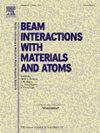TCAD evaluation of single-event burnout and hardening strategies in NiO/β-Ga2O3 heterojunction junction barrier Schottky diodes
IF 1.4
3区 物理与天体物理
Q3 INSTRUMENTS & INSTRUMENTATION
Nuclear Instruments & Methods in Physics Research Section B-beam Interactions With Materials and Atoms
Pub Date : 2025-04-26
DOI:10.1016/j.nimb.2025.165713
引用次数: 0
Abstract
The single-event burnout (SEB) behavior of conventional NiO/β-Ga2O3 heterojunction junction barrier Schottky (C-JBS) diode is investigated, and a multi-buffer trench NiO/β-Ga2O3 heterojunction JBS (MBT-JBS) diode is proposed to enhance SEB tolerance. In C-JBS diodes, SEB-sensitive regions are at the metal/β-Ga2O3 and N−/N+ interfaces. To address this, the MBT-JBS structure uses a trench design and a lower Schottky barrier height to improve hole extraction at the metal/β-Ga2O3 interface, reducing hole accumulation and mitigating electric field-induced heating. The trench also creates a potential difference in the drift and NiO regions, allowing holes to migrate into the NiO region, thereby reducing the risk of SEB. Under a reverse bias of 300 V, the peak temperature at the metal/β-Ga2O3 interface drops by 70 % under heavy-ion irradiation (LET = 37). The multi-layer buffer also eliminates hotspots at the N−/N+ interface, and the MBT-JBS structure withstands an LET of 60 at 400 V without SEB.
NiO/β-Ga2O3异质结结势垒肖特基二极管单事件烧蚀和硬化策略的TCAD评价
研究了传统NiO/β-Ga2O3异质结结势垒肖特基(C-JBS)二极管的单事件烧蚀(SEB)行为,提出了一种多缓冲沟槽NiO/β-Ga2O3异质结肖特基(MBT-JBS)二极管来提高其耐SEB能力。在C-JBS二极管中,seb敏感区位于金属/β-Ga2O3和N - /N+界面。为了解决这个问题,MBT-JBS结构采用了沟槽设计和较低的肖特基势垒高度,以改善金属/β-Ga2O3界面处的空穴提取,减少空穴积累并减轻电场感应加热。海沟还会在漂移区和NiO区产生电位差,使孔洞迁移到NiO区,从而降低SEB的风险。在300 V的反向偏压下,重离子辐照(LET = 37)下,金属/β-Ga2O3界面的峰值温度下降了70%。多层缓冲器还消除了N - /N+界面的热点,并且MBT-JBS结构在没有SEB的情况下可以承受400 V时60的LET。
本文章由计算机程序翻译,如有差异,请以英文原文为准。
求助全文
约1分钟内获得全文
求助全文
来源期刊
CiteScore
2.80
自引率
7.70%
发文量
231
审稿时长
1.9 months
期刊介绍:
Section B of Nuclear Instruments and Methods in Physics Research covers all aspects of the interaction of energetic beams with atoms, molecules and aggregate forms of matter. This includes ion beam analysis and ion beam modification of materials as well as basic data of importance for these studies. Topics of general interest include: atomic collisions in solids, particle channelling, all aspects of collision cascades, the modification of materials by energetic beams, ion implantation, irradiation - induced changes in materials, the physics and chemistry of beam interactions and the analysis of materials by all forms of energetic radiation. Modification by ion, laser and electron beams for the study of electronic materials, metals, ceramics, insulators, polymers and other important and new materials systems are included. Related studies, such as the application of ion beam analysis to biological, archaeological and geological samples as well as applications to solve problems in planetary science are also welcome. Energetic beams of interest include atomic and molecular ions, neutrons, positrons and muons, plasmas directed at surfaces, electron and photon beams, including laser treated surfaces and studies of solids by photon radiation from rotating anodes, synchrotrons, etc. In addition, the interaction between various forms of radiation and radiation-induced deposition processes are relevant.

 求助内容:
求助内容: 应助结果提醒方式:
应助结果提醒方式:


